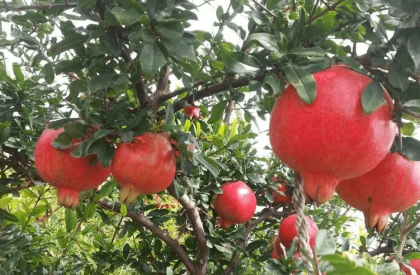Pomegranate


Pomegranate (Punicagranatum L.) is an important fruit crop grown in India.it is originated in Iran and extensively Pomegranate farming in done in the Mediterranean countries like Spain, Morocco, Egypt, Iran, Afghanistan, and Baluchistan. It is cultivated to some extort in Myanmar, China, USA, and India.
India ranks first in pomegranate cultivation in the world. In India major pomegranate producing states are Maharashtra, Karnataka, Gujarat, Andhra Pradesh, Madhya Pradesh, Tamil Nadu, and Rajasthan.
Maharashtra is leading with 90 thousand ha area with annual production of 9.45 lakh Mt tones and productivity of 10.5 Mt/ha. Maharashtra state accounts for 78 percent of the total area in India and 84 percent of the total production in the country.
Pomegranate is one of the most favorite table fruits. The fresh fruits are used for table purpose and also can be used for the preparation of processed products like juice, syrup, squash, jelly, anar rub, juice concentrates, carbonated cold-drinks, anar dana tablets, acids, etc.
Pomegranate fruit is nutritious, rich in minerals, vitamins, and proteins. The juice is useful for leprosy suffering patients.
Climate
For the Successful pomegranate cultivation, it is essentially dry and semi-arid weather, where cold winter and high dry summer quality enables fruit production. Pomegranate plant can tolerate frost to some extent and may be considered drought-tolerant.
The optimum temperature for fruit development is 35 -38 ° C.
The region with 500 m above from sea level is best suited for pomegranate cultivation.
Soil
Considering the soil requirement, it can be grown under different types of soil, from low-fertile to high-fertile soil. However, in deep loamy, it gives very good yield. It can tolerate salinity and alkalinity in the soil to a certain extent
Soil having pH range between 6.5 – 7.5 is ideal for Pomegranate farming
Propagation method
Pomegranate plant can be commercially propagated through hardwood cutting, air layering, and tissue culture.
Hardwood cutting propagation:
Its easy method but its success rate is lesser, so this method is not popular among farmers. For Cutting selected from a one-year-old tree of 9 to 12 inches (25 to 30 cm) long having 4-5 buds are better for higher rooting and survival.
Air-layering propagation:
Its most common practice by farmers for raising new plants. For air layering method, select 2 to 3 years old plants and air-layered followed by IBA (1,500 to 2,500 ppm) treatment for better rooting.
From a single plant around 150 to 200 rooted cuttings can be obtained.
Rainy season is best suited for layering. It takes around 30 days for roots. After 45 days, the layered plants should be detached from the mother plant.
Expert Pomegranate grower identifies detach time by the observing colour of roots when it starts to turn brown the layered cuttings are separated. Then these are grown in polybags and kept for hardening up to 90 days under shade net or Greenhouse.
Progressive banana varieties
In local languages, this banana is known as Bhusavali, Basrai, Marisas, Kabuli, Sindurani etc.
It is very popular in India.
Its plant is small, while the fruits are large.
Its pulp appears soft and sweet in food.
This variety is also known as Bambegreen and Harichal.
The areas of the Western Deep Group are famous mainly for its cultivation.
The banana plants can be 3 to 4 meters in height.
While their stem is medium thick and thick green.
Green fruits develop in them.
On an average, each bunch weighs between 25 and 30.
Fruits are yellow.
Customer Feedback
Talented Agronomist
Team Alexa made my Poly-House very well & also helped by assisting in organic Framing. Thanks & All the Best for the future.
Ms. Poonam Saxena, Indore (M.P.)
landownerExcellent job, excellent workmanship
Currently, Team Alexa helping me on Orchid Cultivation in Poly house. I’ve have to say till now everything is good and expecting the same for future.
Mr. Rajendra singh , Indore (M.P.)
landownerGreat ! Work
I would suggest Alexa Farms for Poly house Farming , Hi Tech Farming Organic Farming because there professionals have knowledge for all the crops.
Mahant Dharmendra Puri, Indore
landownerDone Wonderful job
Amazing design and installation of our new, beautiful yard. Gardener is professional, creative and knowledgeable designer.
Mark Angelino
NewyorkPlanting & Removal Charges
Within a your budget you can freshen up your plant with a few key upgrades that will increase your home’s curb appeal. A new gravel driveway or concrete walkway can make your home look like new. Small budgets are good for breaking up a larger project into manageable chunks, so you might splurge for a nice walkway this year and deal with the driveway later.

